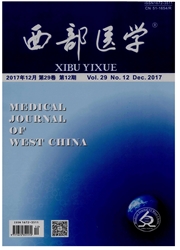

 中文摘要:
中文摘要:
目的评价尼达尼布治疗特发性肺间质纤维化(IPF)的安全性。方法分别用“尼达尼布”“特发性肺间质纤维化”以及“nintedanib”“IPF”依次为关键词,检索PubMed、Embase、Medline等外文数据库及中国知识基础建设数据库、维普数据库、万方数据资源系统等中文数据库2017年2月前收录的文献。筛选文献条件包括尼达尼布治疗IPF的随机对照试验(RCT)和观察性研究。在筛选的原始文献中,试验组口服尼达尼布,对照组口服安慰剂。结局指标主要终点事件是尼达尼布治疗IPF的各种不良反应发生率。使用RevMan5.3软件进行Meta分析。结果最终纳入包括4项RCT。Meta分析结果,试验组在IPF进展[9.68%(95/981)比14.2%(72/508),RR=0.66,95%CI0.48-0.93,P=0.02],心脏功能紊乱[1.22%(12/981)比2.56%(13/508),RR=0.41,95%CI0.19-0.91,P=0.03]以及致命的不良反应[5.81%(57/981)比8.46%(43/508),RR=0.64,95%CI0.42-0.97,P=0.04]发生率低于对照组。试验组在呼吸系统的不良反应,包括咳嗽[14.4%(141/981)比14.6%(74/508),RR=0.93,95%CI0.68-1.27,P=0.64],支气管炎[11.2%(110/981)比11.0%(56/508),RR=0.98,95%CI0.69-1.39,P=0.91],鼻咽炎[13.3%(90/676)比15.6%(68/435),RR=0.84,95%CI 0.60-1.18,P=0.32]及呼吸困难[9.07%(89/981)比11.6%(59/508),RR=0.70,95%CI0.49-1.01,P=0.06],药物的严重不良反应,如一些不可恢复的不良反应[28.0%(285/1019)比29.14%(153/520),RR=0.97,95%CI0.77-1.23,P=0.81],以及终止研究的不良反应[19.5%(199/1019)比14.8%(77/520),RR=1.33,95%CI0.99-1.77,P=0.33]发生率与对照组比较差异无统计学意义。结论尼达尼布治疗IPF不良反应轻微,多可恢复、可耐?
 英文摘要:
英文摘要:
Objective To evaluate the effectiveness of nintedanib in treatment of idiopathic pulmonary fibrosis(IPF). Methods Pubmed, Embase, Medline, CNKI, VIP Database, Wanfang Database till Feb. 2017 were searched using the key-words nintedanib and idiopathic pulmonary fibrosis. Randomized controlled trials (RCT) of nintedanib in treatment of IPF were selected. The patients in the trial group were given nintedanib while the patients in the control group were given oral placebo. The primary end point of the outcome was the incidence of adverse events. The Meta-analysis was performed using RevMan 5.3. Results A total of 4 RCTs were enrolled. The incidences of many kinds of adverse events in the trial group were markedly lower than those in the control group, including progression of idiopathic pulmonary fibrosis [ 9.68% (95/ 981 ) vs 14.2% (72/508), RR = 0. 66,95% CI 0. 48-0.93, P = 0.02 ], cardiac disorder [ 1.22% ( 12/981 ) vs 2.56% ( 13/ 508) ,RR = 0.41,95% CI 0. 19-0.91 ,P =0.03 ] ,fatal adverse event[ 5.81% ( 57/981 ) vs 8.46% (43/508) ,RR = 0.64, 95% 0.42-0.97, P = 0.04 ]. However, there was no statistical significant difference in treatment-related serious events including cough [ 14.4% ( 141/981 ) vs 14.6% ( 74/508 ), RR = 0.93,95 % CI 0. 68-1.27, P = 0.64 ], bronchitis [ 11.2% ( 110/981 ) vs 11.0% (56/508), RR = 0.98,95 % CI 0. 69-1.39, P = 0.91 ], nasopharyngitis [ 13.3 % (90/676) vs 15.6% ( 68/435 ), RR = 0.84,95 % CI 0.60-1.18, P = 0.32 ], dyspnea [ 9.07 % ( 89/981 ) vs 11.6 % ( 59/508 ), RR = 0.70,95 % CI 0. 49-1.01 ,P =0.06] ,serious adverse events [ 28.0% (285/1 019) vs 29.4% ( 153/520), RR = 0.97,95% CI 0. 77- 1.23 ,P = 0.81 ], adverse event leading to study discontinuation [ 19.5% (199/1019) vs 14.8% ( 77/520), RR = 1.33, 95% CI 0. 99-1.77 ,P = 0.33 ]. Conclusion The adverse events are mild and mostly recoverable without obvious sequelae, so nintedanib is safe and well-tolerated.
 同期刊论文项目
同期刊论文项目
 同项目期刊论文
同项目期刊论文
 期刊信息
期刊信息
